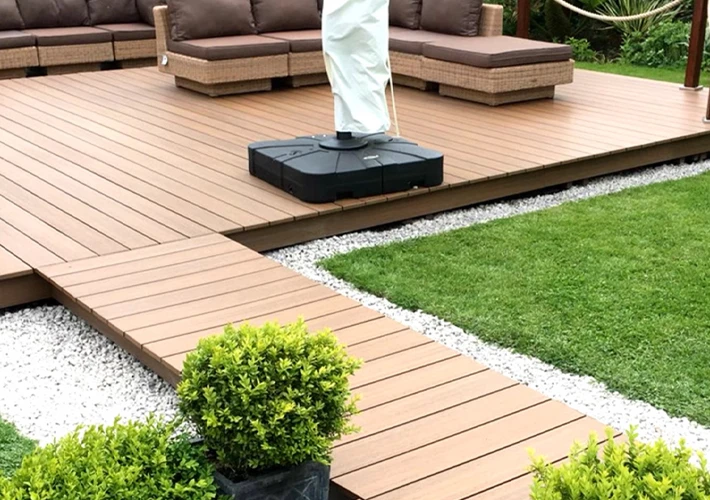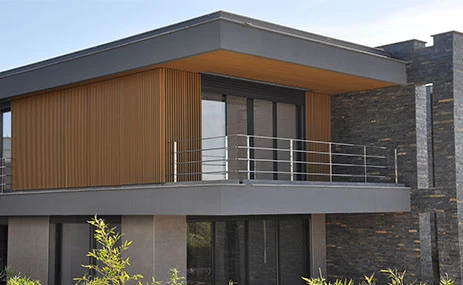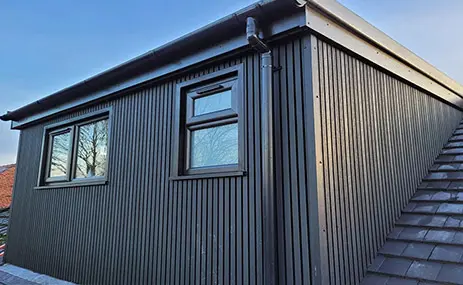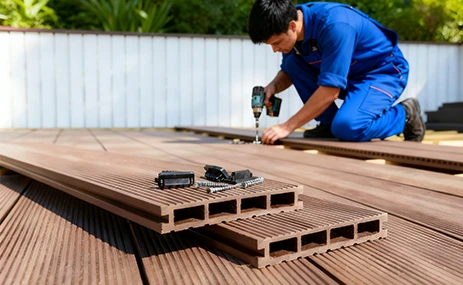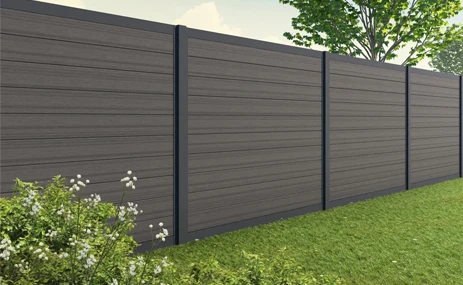Table of Contents
ToggleIntroduction
In recent years, composite decking has revolutionized the outdoor living and construction industries. Whether for residential gardens, commercial patios, resort boardwalks, or marine docks, composite decking offers the perfect blend of natural beauty, durability, and low maintenance. However, with so many brands, materials, and specifications available on the global market, choosing the best composite decking can be challenging.
This comprehensive guide will help you understand what to look for — from material composition and surface treatment to installation methods and supplier selection. Whether you are a homeowner, contractor, or wholesale importer, this article will give you the professional insights you need to make an informed decision.
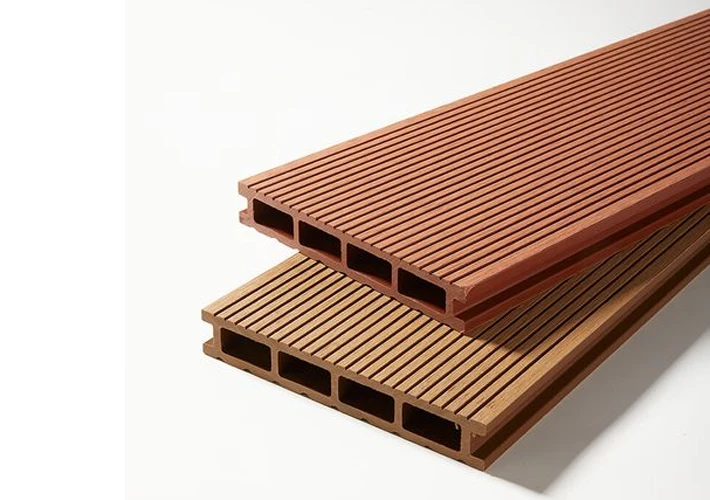
What is Composite Decking?
Composite decking is a modern alternative to traditional wood decking. It is typically made from a mixture of wood fibers (or wood flour) and plastic polymers (usually polyethylene or polypropylene). These materials are combined through extrusion or molding to create boards that look like wood but perform far better in terms of weather resistance, moisture protection, and longevity.
There are two main types of composite decking:
- WPC (Wood Plastic Composite) Decking: A combination of wood fiber and thermoplastic resin. It offers a natural wood appearance with enhanced water and insect resistance.
- Capped Composite Decking: A WPC core with an additional polymer cap layer that improves UV resistance, color stability, and scratch protection.
Key Advantages
- No painting or sealing required
- Longer lifespan (15–25 years)
- Resistant to fading, rot, and termites
- Slip-resistant surface
- Environmentally friendly (often made from recycled materials)
Factors to Consider When Choosing Composite Decking
Selecting the right composite decking involves evaluating multiple factors. Below are the most important criteria that determine quality, durability, and suitability for your project.
2.1. Material Composition
The composition determines how the decking performs over time.
| Type | Description | Advantages | Disadvantages |
|---|---|---|---|
| WPC Decking (Uncapped) | Blend of wood fiber & plastic | Cost-effective, eco-friendly | May fade slightly under UV exposure |
| Capped WPC Decking | WPC core with polymer shell | Excellent weather & color resistance | Slightly more expensive |
| Co-extrusion Decking | Dual-layer technology | High surface hardness, low maintenance | Higher production cost |
A high-quality composite decking board typically has:
- 55–60% wood fiber
- 30–35% HDPE (High-Density Polyethylene)
- 5–10% additives (stabilizers, pigments, lubricants)
Choosing boards with the right material ratio ensures balance between strength, flexibility, and longevity.
2.2. Surface Texture and Design
Composite decking is available in a range of textures, colors, and patterns, allowing it to match different architectural styles.
Common Surface Styles
- Wood Grain Finish: Mimics natural timber. Ideal for residential decks or resort areas.
- Brushed or Embossed Finish: Anti-slip surface suitable for pool decks or public walkways.
- 3D Deep Embossed Surface: Provides a rich texture that enhances both appearance and durability.
Color Options
From teak, walnut, and redwood to gray, black, and light oak, modern composite decking offers dozens of hues. Always select UV-resistant colors if your project is in sunny regions such as the Middle East, Australia, or the southern United States.
2.3. Density and Weight
A good composite decking board should have balanced density and weight. Too light may reduce strength; too dense may increase cost and difficulty in installation.
Typical density range:
- WPC Decking: 1.2–1.4 g/cm³
- Co-extrusion Decking: 1.3–1.5 g/cm³
Higher density generally indicates stronger compression resistance and better dimensional stability.
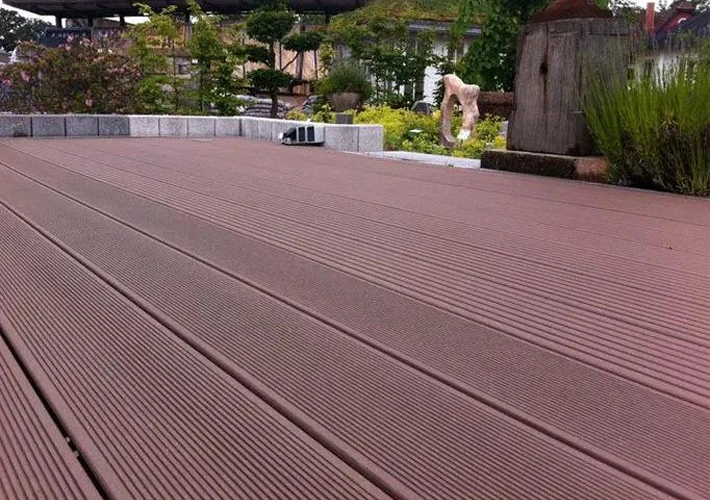
2.4. Hollow vs. Solid Boards
Composite decking is produced in both hollow and solid structures. Each type serves different applications.
| Type | Features | Best For |
|---|---|---|
| Hollow Decking | Lightweight, economical, easy to install | Residential decks, balconies, DIY projects |
| Solid Decking | Heavy-duty, higher load capacity | Commercial decks, boardwalks, high-traffic areas |
If your project involves heavy furniture or public areas, solid decking is recommended. For cost-sensitive or lightweight structures, hollow decking provides great value.
2.5. Slip Resistance
Safety is crucial. Look for decking with anti-slip certification, especially if it will be installed near pools, docks, or bathrooms.
Surface roughness and texture design directly affect slip resistance.
High-quality WPC decking typically achieves:
- R11–R13 slip resistance rating (DIN 51130 standard)
2.6. Color Fading and UV Resistance
Exposure to sunlight can cause discoloration over time. The best composite decking uses UV stabilizers and anti-oxidants to minimize fading.
Premium co-extruded boards maintain color stability within:
- ΔE ≤ 3 after 2000 hours of UV exposure
This ensures the deck retains its original aesthetic for many years.
2.7. Water and Moisture Resistance
Traditional wood easily absorbs water, leading to warping and cracking. Composite decking, however, is highly water-resistant.
Test data shows:
- Water absorption rate: < 1%
- No swelling or deformation after 24-hour immersion
For humid or rainy environments, such as coastal cities or tropical regions, this property is particularly valuable.
2.8. Installation and Maintenance
Composite decking is known for easy installation and minimal maintenance.
Look for:
- Hidden fastener systems for clean surface appearance
- Adjustable pedestal systems for slope areas
- Removable clip systems for quick replacement
Maintenance involves only regular sweeping and washing with mild soap and water, no sanding or painting required.
2.9. Environmental Sustainability
More buyers are paying attention to sustainability. High-quality manufacturers use recycled plastics and reclaimed wood fibers to produce eco-friendly decking that meets environmental regulations such as:
- REACH, RoHS, and CE certification
Choosing eco-composite decking supports sustainable building practices and enhances your corporate image in global trade.
2.10. Warranty and Certification
Reliable composite decking manufacturers offer:
- 10–25 years warranty
- ISO9001 / ISO14001 certification
- SGS / Intertek test reports
These certifications ensure consistent quality and compliance with international standards.
Popular Composite Decking Sizes and Specifications
Choosing the right size ensures structural safety and aesthetic harmony.
| Specification | Hollow Decking | Solid Decking |
|---|---|---|
| Width | 135mm / 145mm / 150mm | 140mm / 150mm / 160mm |
| Thickness | 20mm–25mm | 23mm–30mm |
| Length | 2200mm–5800mm | 2200mm–5800mm |
| Surface Finish | Wood grain / Brushed / Sanded | 3D embossed / Co-extruded |
| Density | 1.2–1.3 g/cm³ | 1.3–1.5 g/cm³ |
Custom sizes can also be manufactured for large commercial projects or OEM orders.
Comparing Composite Decking with Traditional Wood
| Feature | Composite Decking | Natural Wood Decking |
|---|---|---|
| Durability | 15–25 years | 5–10 years |
| Maintenance | No painting or sealing | Annual repainting needed |
| Water Resistance | Excellent | Poor |
| Termite Resistance | Yes | No |
| Cost Over Lifetime | Lower | Higher |
| Aesthetic Variety | Wide range | Limited to natural tones |
Composite decking offers better cost performance over time due to reduced maintenance and replacement expenses.
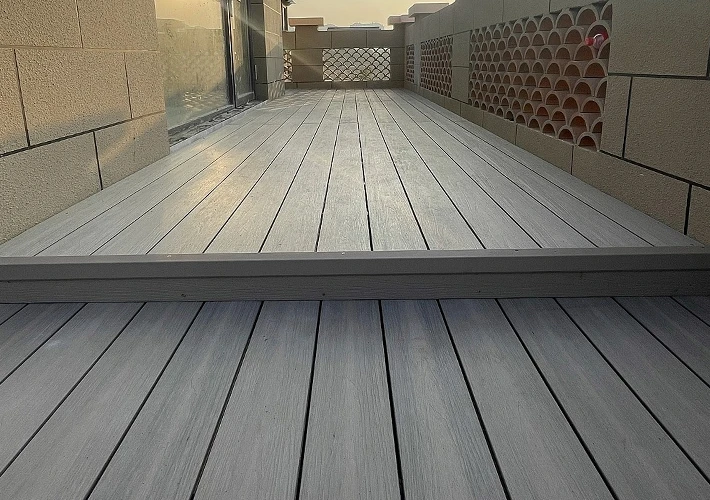
Common Applications of Composite Decking
Composite decking is widely used across residential, commercial, and public projects.
Residential Applications
- Backyard decks and patios
- Garden walkways
- Swimming pool surrounds
- Rooftop terraces
- Balconies
Commercial & Public Applications
- Resort boardwalks
- Outdoor restaurants and cafes
- Hotel courtyards
- Marina docks and waterfronts
- Public park platforms
Composite decking not only enhances aesthetic appeal but also increases property value.
Tips for Choosing the Best Supplier
Selecting a reliable composite decking supplier is just as important as choosing the product itself.
6.1. Factory Scale and Experience
Look for manufacturers with:
- Over 10 years of production experience
- Automated extrusion lines
- Independent R&D capability
6.2. Product Range
A strong supplier can provide:
- WPC Decking
- Co-extrusion Decking
- WPC Wall Panels
- WPC Fencing and Pergolas
- This ensures product consistency and convenient one-stop procurement.
6.3. Quality Control
Leading Chinese suppliers follow strict ISO quality systems and conduct tests for:
- Color stability
- Bending strength
- Impact resistance
- Water absorption
6.4. Export Experience
Check whether the supplier has exported to markets such as:
- The United States
- Europe
- Australia
- Middle East
- Export experience indicates compliance with international quality and packaging standards.
6.5. OEM & Customization Capability
For distributors or brands, OEM service is crucial. Reliable factories can:
- Customize color, size, texture, and packaging
- Offer branding and logo printing
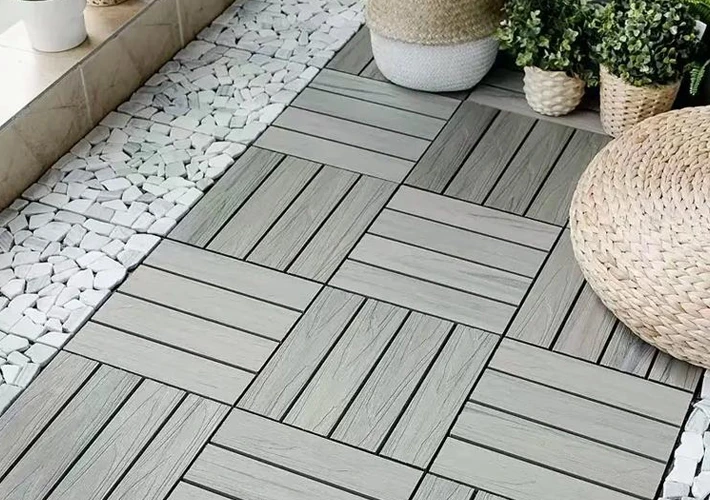
Estimated Price Range of Composite Decking (2025)
| Type | Average FOB Price (China) | Features |
|---|---|---|
| Hollow WPC Decking | $8–$13 / m² | Lightweight, economical |
| Solid WPC Decking | $13–$20 / m² | Strong load capacity |
| Co-extrusion Decking | $18–$28 / m² | Premium UV and color protection |
| 3D Embossed Decking | $15–$25 / m² | Natural texture, stylish appearance |
Note: Prices vary based on raw material cost (HDPE and wood fiber), production technology, and order quantity.
How to Maintain Composite Decking for Long Life
Although composite decking is low-maintenance, proper care can further extend its service life.
Maintenance Tips
Clean regularly using water and mild detergent.
Remove stains promptly to prevent discoloration.
Avoid sharp metal tools during installation or cleaning.
Ensure proper ventilation under the decking to reduce moisture accumulation.
Check fasteners periodically to ensure stability.
With minimal effort, composite decking can last 20 years or more while maintaining its beauty and function.
Future Market Trends of Composite Decking
According to global building material reports, the composite decking market is expected to grow at over 10% CAGR between 2025–2030.
Key trends include:
- Eco-friendly materials and recyclability
- Co-extrusion and 3D embossed technology upgrades
- Smart decking systems with hidden drainage channels
- Increased demand in Europe, the U.S., and Australia
As urbanization and outdoor lifestyle trends continue, composite decking will remain one of the fastest-growing segments in decorative materials.
Conclusion
Choosing the best composite decking requires careful evaluation of material quality, design, structure, and supplier reliability.
If you prioritize:
- Durability and weather resistance → choose co-extrusion decking
- Cost-effectiveness and easy installation → choose hollow WPC decking
- High-end appearance and color stability → choose 3D embossed or capped decking
For importers and global project contractors, cooperating with a trusted Chinese factory can ensure stable supply, competitive pricing, and customization flexibility.
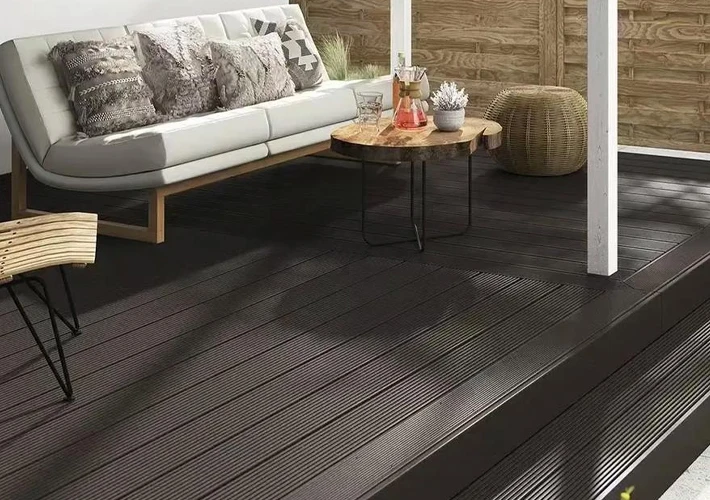
Contact a Reliable WPC Decking Supplier in China
As a leading composite decking manufacturer and exporter, we offer:
- A full range of WPC and co-extrusion decking
- Customized solutions for global clients
- Competitive factory prices
- Professional packaging and shipping service
Whether you are a wholesaler, contractor, or brand distributor, our team is ready to support your projects with high-quality decking and timely delivery.
Contact us today to get free samples and the latest factory quotations!


